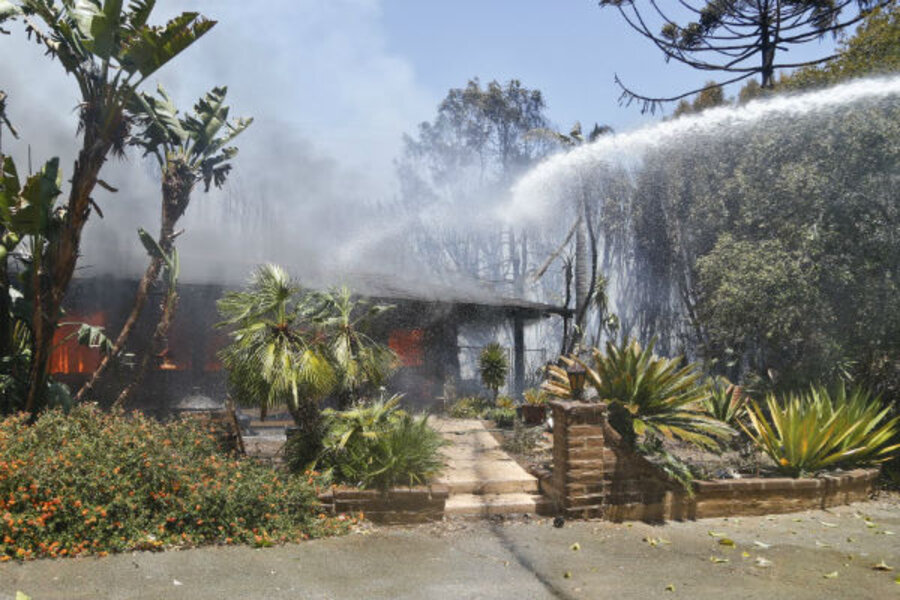California wildfires set relentless pace months before typical season
Loading...
| LOS ANGELES
San Diego residents are bracing for a second day of wildfires, with temperatures expected to hit a high of 106 degrees, after at least nine fires closed schools and roads forced more than 21,000 people from their homes on Wednesday.
Thousands remain perched in front of their television sets, watching local broadcast team coverage of wildfires and hoping the wind won’t bring the fire and smoke toward their own communities.
For many Californians, the wildfire season has settled into expectation and habit. But this year, the highly flammable combination of record heat, the seasonal Santa Ana winds, and lack of rain are exacerbating the problem and producing severe fire conditions several months ahead of the usual fire season.
California fire, civic, and police officials up and down the state are admonishing residents that more could be on the way with the state’s worst drought in a century and blistering Santa Ana winds resulting in some of the hottest May temperatures since record-keeping began in 1896.
“The drought conditions have left much of California much more dry than usual this time of year,” says Daniel Berlant, chief information officer for the California Department of Forestry and Fire Protection, also known as Cal Fire.
“The public needs to understand it doesn’t take much to spark a fire so we are asking people to be extremely careful whenever they are outside. The smallest spark can become a fire that quickly grows into a fast moving wildfire.”
Funds and firefighters are exhausted with the relentless pace of the state’s 1,244 wildfires this year – already triple the state average – and US Interior Department officials are predicting no letup.
San Diego appears to be the hardest hit with at least nine different fires that have forced the closing of California State University at San Marcos and the San Diego Unified School District. At least 10,000 acres have burned, along with dozens of homes. Palomar College canceled Wednesday night activities but says that Thursday classes are still on.
The countywide notification system called “Alert San Diego” sent out 122,000 emergency telephone notifications on Wednesday. Many roads have been shut down so that fire trucks and emergency vehicles can have access to affected neighborhoods.
The worst fire seems to be in Carlsbad, where the speed of the winds is proving hazardous to helicopters, which are grounded when gusts reach 35 m.p.h. Wind gusts remained steady at 30 m.p.h at Carlsbad on Wednesday, with temperatures of 100 degrees and only 3 percent humidity. Thursday is expected to be the hottest day of the week according to the National Weather Service, with forecast highs between 98 and 106. At least eight homes and two commercial buildings have been lost there.
“People were very surprised that it came that close to the business district. There are a lot of big companies there,” said Carlsbad information officer Jay Ringgold to CNN. Resident Kristin Michalec told the station: “It was so hard to see because of the thick smoke.” By 7 a.m. local time, there were no reports of fatalities or major injuries.
Specially equipped firefighting helicopters and air-tanker planes doused smoke-filled neighborhoods with fire retardant and seawater while evacuees scanned their smart phones for information on where to find accommodations, food, and centralized information banks to locate family and friends. Eleven thousand were evacuated in the Carlsbad area late Wednesday. Legoland amusement park in north Carlsbad had to close.
Among the other developments:
- A fire ignited around Camp Pendleton, the giant Marine base and training ground for several military branches, leading to evacuations of a senior housing facility, a child development center, and an elementary school.
- The region around San Onofre nuclear power plant was ordered evacuated. The plant has been offline since 2012, and Southern California Edison assured residents that “there is no safety threat.”
- The Lompoc community in Santa Barbara is on alert.
- Poway Unified School District reopened schools Wednesday, a day after flames broke out in the fire-prone Rancho Bernardo area of the city, forcing students to be evacuated from schools.
- The flames ripped through canyons near expensive homes and new subdivisions on the ridges and spread to Rancho Santa Fe, one of the nation's wealthiest communities, known for its multimillion-dollar homes, horseback riding, and golf.
Broadcasters are telling viewers to tune to cdfdata.fire.ca.gov for the latest information on which direction the fires are headed and how much they are contained. They are being told to scan https://www.sdsheriff.net/ for evacuation and “all clear” orders.







